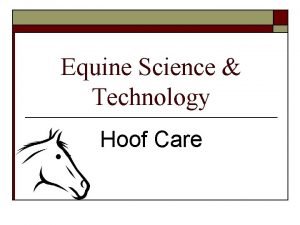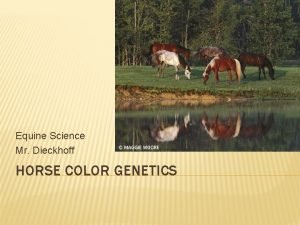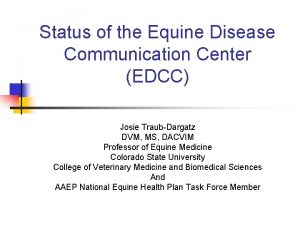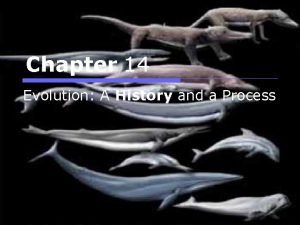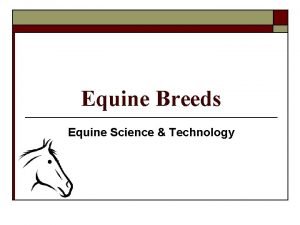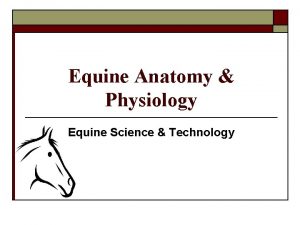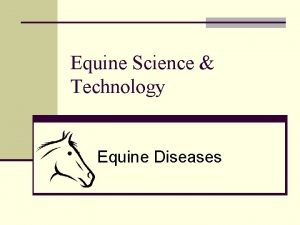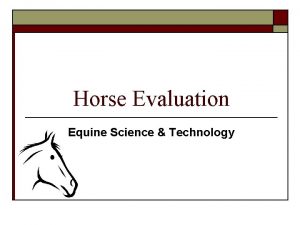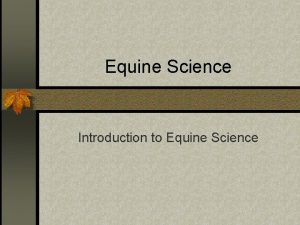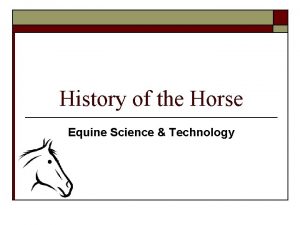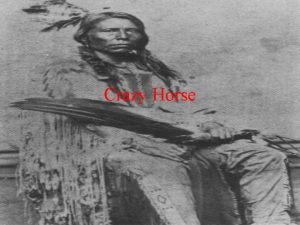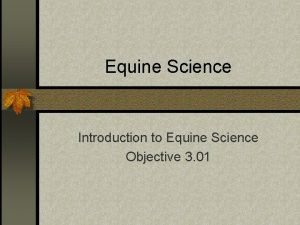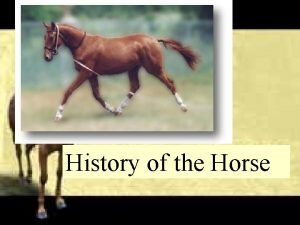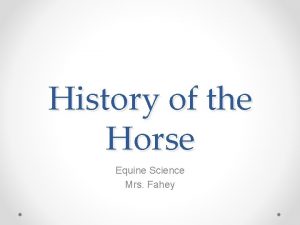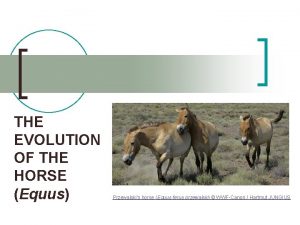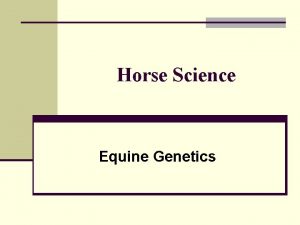Equine Science Evolution of the Horse History of








































































- Slides: 72

Equine Science Evolution of the Horse History of the Horse

Questions? ? • What are the evolutionary changes of horses? • How has the climate affected their evolutionary process? • How has recent human interaction affected their evolution?

THE EVOLUTION OF THE HORSE (Equus)

Classification Equine Science presentation #1 4

The odd-toed ungulates • Horses belong to the order Perissodactyla, the odd-toed ungulates. • a mammal with hooves that feature an odd number of toes on the rear feet • relatively simple stomachs because they are hindgut fermenters, digesting plant cellulose in their intestines rather than in one or more stomach chambers • This group includes horses, zebra, donkeys, rhinos and tapirs White Rhinoceros (Ceratotherium simum) © KHW

Equus • The genus Equus includes horses, zebra and donkeys • The last remaining branch of a diverse group of equids • Similar to the status of Homo sapiens, the last remaining species of a once diverse group of Hominids • The evolution of the horse is much better documented than ours • The fossil record is very complete

Evolution of the horse • Eohippus (a. k. a. Hyracotherium) • Earliest ancestor to our present horse • Small primitive horse about the size of a fox • Elongated skull, arched back, shortened tail, four functional toes on front feet, and three toes on hind feet • 54 million years old Equine Science presentation #1 7

Equine Science presentation #1 8

Evolution of the horse • Mesohippus • Appeared when grasslands formed • Larger than Eohippus, teeth further evolved, three toes on front feet, better suited to out run enemies • Earth had changed – forest became thinned and grass increased • 35 – 40 million years old • 24 inches at shoulder • Became extinct about 7 million years ago Equine Science presentation #1 9

Equine Science presentation #1 10

Equine Science presentation #1 11

Evolution of the horse • Merychippus • Arose 20 million years ago • Evolved in North America • Adapted to the hard grasses of the plains • Beginning of the grazing horse of today • Size: 35 – 40 in. , gregarious and lived in herds • Developed grinding teeth similar to present day horse, lateral toe disappeared, middle toe thickened and hardened Equine Science presentation #1 12

Equine Science presentation #1 13


Evolution of the horse • Pliohippus • Developed ~ 5 million yrs ago • First true monodactyl (one-toed animal) • Teeth and limbs were the closest to present-day horse • Spread into S. America, Asia, Europe, and Africa • 8, 000 year ago Equus became extinct in the Western Hemisphere and did not return until the Spanish brought horses in 1400’s Equine Science presentation #1 15



Equus caballus • ~2 million years ago • Modern day horse • Became extinct in N. America • ~8, 000 yrs ago • Was not to return until • Spanish arrived in 1400’s


Pleistocene (15, 000 to 2 million years ago) This era in the horses evolutionary time frame happened to be during and after the last Ice Age Many animals did not survive this drastic shift in climate

Why did horses survive this drastic shift in climate while other large animals did not?

Pleistocene (15, 000 to 2 million years ago) Horses adapted to surviving almost solely off of grasses They evolved a cecum to help digest the cellulose found stems and leaves of plants The cecum allows horses to survive in very poor-quality areas This adaptation allows them to withstand a high-fiber di and to avoid competition among other species This may have also lead to the increase in their size

Pleistocene (15, 000 to 2 million years ago) • Evolved a larger brain that may have been relate to more sensitive lips for effective foraging • 3 -toed to 1 -toed helped make them more efficie at fleeing from predators

Pleistocene (15, 000 to 2 million years ago) Other traits that evolved were some juvenile characteristics (Neoteny) • Higher curiosity • Flexibility or adaptability to environmental changes • A more playful nature • Submissiveness • Dependency These characteristics or traits lead to an easier domestication of the horse by man

Pleistocene (15, 000 to 2 million years ago) After the Ice Age, approximately 15, 000 years ago, the horse became extinct in North America This extinction was due to overhunting by the people occupying North America at the time Horses were close to extinction in Europe and Asia but their domestication saved them as a species

Evolution of the horse • Four Trends in the Line of Descent • Reduction in the number of toes • Increase in the size of the cheek teeth • Lengthening of the face • Increase in body size • Evolving along with the modern horse were other species of Equus I. e. donkeys, onager, and zebras Equine Science presentation #1 26

volution of the horse Przewalski Horse • Rediscovered in Mongolia in 1879 • Wild horse who maintained itself in Europe and Asia during 60 million years of evolution • Small, heavily built, and yellowish colored with an erect mane • Przewalski horse has 66 Chromosomes and the domestic horse has 64 Equine Science presentation #1 27


Trends in the evolution of the horses • Increased size • Reduced number of toes and longer legs • A stiffer back Merychippus 20 Ma Equus

Teeth for grazing • Larger teeth and a larger skull to hold them

Teeth for grazing • Teeth with bands of hard (enamel) and soft (dentine) material on the crown • Open tooth roots permitting continuous growth

Trends in the evolution of the horses • The trends correspond to changes in the climate and vegetation of the Earth over the past 55 million years, • combined with the arms race between predators and prey. From……. . rich rainforest which covered most of the Earth in which the horses ancestors browsed on leaves and hid from predators. To ……. open savannah grassland where the modern horses grazed grass and had to run from predators.

Evolution of the Horse • Did not occur in a straight line • Many horse like animals branched off • Now one genus is the only surviving branch of a once large evolutionary bush • Equus

History and Evolution • Kingdom: Animalia • Phylum: Chordata • Class: Mammalia • Order: Perissodactyla • Family: Equidae • Genus: Equus • Specie: several

Species • Equus caballus • True horse • Once had several subspecies

Species Equus przewalski • Oldest living specie of horse • Not discovered until 1879 • Russian Captain named Nikolai Przewalski • Discovered in Mongolia • Ancestor of modern horse • Cannot be domesticated • Characteristically Dun

Species • Equus asinus • The true asses and donkeys of northern Africa

Species quus burchelli • Plains Zebra of Africa – “typical” zebra • Several Subspecies • Wide vertical stripes • Thick horizontal stripes on the rump • Found in Eastern and Southern Africa

Species • Equus grevyi • Grevy’s zebra, most horse like zebra • Native to Eastern Africa • Big Zebra with very narrow vertical stripes & huge ears

Evolution • 24 min • https: //www. youtube. com/watch? v=qt. X 3 ir 4 e. WM M Equine Science presentation #1 40

History, Domestication & Early Use Equine Science presentation #1

Domestication & Early Use • When were horses were first used? • ~50, 000 yrs ago • Crow-Magnon hunters would: • Herd horses over cliffs • Butcher for meat, bone, and hide • Skeletal remains • ~100, 000 horses found in France

Domestication & Early Use • When were horses were first domesticated? • ~ 4, 000 B. C. on • Kept for meat and possibly milk • For work needs, what proceeded the horse? • Ass and Ox • More docile and easier to domesticate • When were horses first used for labor? • ~2, 000 B. C. in Mesopotamia

History, Domestication & Early Use • The Chinese likely first domesticated horses • Horses were initially (even before domestication used for food. Equine Science presentation #1 44

• Domestication: to tame (an animal), especially by generations of breeding, to live in close association with human beings as a pet or work animal and usually creating a dependency so that the animal loses its ability to live in the wild. Equine Science presentation #1 45

Domestication & Early Use • How were horses first controlled? • Nose ring • Due to effective control of ox by same method • Popular chariot method of transportation • Why did horse replaced the Ox? • Speed

Domestication & Early Use Why did man began to ride the horse? • Either for convenience or economy Nose rings were replaced by what? • Snaffle Bit Who invented snaffle bit? • Romans ~1500 B. C. • First time reins were on each side of the neck • Stirrups and saddles still unknown at this time

History of the Horse Egyptians • 1680 BC Dynasty of Shepherd Kind • Invention of chariot • Replaced donkeys Egyptians had a large responsibility for the spread of domesticated horse Equine Science presentation #1 48

Equine Science presentation #1 49

History of the Horse Rome • Invented the curved bit • Horses used in the invasion of Britain 55 BC • 520 -632 AD Mohammed • Arabs began to use horses • Wild horses of Asia (now extinct) gave rise to the Arabian, Barb, and Turk • The Thoroughbred originated from these stocks. Equine Science presentation #1 50

Uses of the Horse and Inventions • Early uses of horses transformed: • Travel • Warfare • Economics • Culture • Social Organization • Political Boundaries • Languages Equine Science presentation #1 51

Hippology and War • Hippology is the study of horses • The use of horses in war (mounted cavalry) probably led to the serious study of equitation • Ability of the rider to ride correctly, etc • https: //www. youtube. com/watch? v=2 Kl. Gm. P x. W 8 P 4 Equine Science presentation #1 52

History of Horses in the US • Horses traveled to the Americas with Columbus on his second voyage. They were necessary for transportation and to carry the early Spaniards on their expeditions. • Horses were not here when Columbus “found” America in 1492 Equine Science presentation #1 53

History of Horses in the US • The horses that escaped or were abandoned reverted to a wild state and increased in numbers to become the mustang bands found by early adventurers and Indians as they moved west. Short https: //www. youtube. com/watch? v=VKi 8 K_7 xwo Long: https: //www. youtube. com/watch? v=u 5 X 7 i. KW DILA Equine Science presentation #1 54

Horses helped the Indian to kill buffalo and to car on hostile activities against invaders.

Wild Mustangs Equine Science presentation #1 56

Colonists’ Horses • European colonists’ brought horses that were used to pull heavy loads (wagons, plows, etc) • These types of horses are known as draft horses Equine Science presentation #1 57

Horses of the Southeast US • Large plantations of the southeast US created the need for saddle horses • Plantation owners wanted smooth, comfortable horses to ride. • Horse racing became popular about this time • 1730, plantation owners started importing English racehorses Equine Science presentation #1 58

Horses in the US 1861 Mail Service “Pony Express” began • Only operated for 18 months Used during wars Army maintained horses until WWII Equine Science presentation #1 59

Golden Age of the Horse ~1890’s until the large scale mechanization of agriculture The rise of mechanization and commerce led to a rise in the number of horses. A record high of nearly 21. 5 million horses in 1915 (USA only) • Compared to around 6. 9 million today (USA) Equine Science presentation #1 60

Equine Science presentation #1 61

The Horseless Carriage • Henry Ford starts producing the first affordable automobile in 1908 • This ushered in the age of mechanization • Leads to a decrease in the number of horses • Not until 1950’s do the number of automobiles and tractors surpass the number of horses • Horse numbers reached an all time low of 3. 1 million in 1960 Equine Science presentation #1 62

Millions of Horses, Autos, Tractors Equine Science presentation #1 63

Replacing the Horse • As the country became more urbanized and the automobile becomes more popular the need for horses as a means of transportation decreases • The number of tractors used on farms passes the number of horses used in 1954 Equine Science presentation #1 64

he Horse Today • Most horses today are light horse breeds popular for pleasure riding and recreation • Texas, Oklahoma, and California have the highest horse populations • The Quarter horse, Paint, and Thoroughbred are three most popular ( & registered) breeds Equine Science presentation #1 65

The future of the Horse populations are rebounding as they become more popular for recreational riding because people have more time and money for leisure activities The need for horses for recreation and sport will be the dominant factor in the future of the horse industry Equine Science presentation #1 66


Status and Future of the Horse Industry • Majority of the world’s horses, donkeys, and mules • Not found in the U. S • What % of horses in U. S. ? • 8% • What % of donkeys and mules • >1%

Status and Future of the Horse Industry How many horses in the world? • ~60 million Where are the majority found? • More than half are found in • Asia and South America Mexico, Europe, and U. S. • All have significant populations


Assignment • Write a one page paper about an experience with a horse(s). • • Positive experiences Negative experiences Life changing experience Funny story • If you have limited experience with horses – what are your impressions of them. What interests you about them? Equine Science presentation #1 71

Assignment • Create a time line from the beginning of the Equus to the modern day horse. Include 2 facts for each of the era’s (Mesohippus, Eohippus, etc) we covered. • Use a sheet of computer paper to complete the assignment.
 Equine science
Equine science Equine science
Equine science Prehistoric horse
Prehistoric horse Horses before evolution
Horses before evolution Exclusively equine vet
Exclusively equine vet Lingfield equine vets
Lingfield equine vets Equine definition
Equine definition Pony club stall card
Pony club stall card Equine encephalitis
Equine encephalitis Equine encephalitis
Equine encephalitis Pasture pals equine rescue
Pasture pals equine rescue Equine viral rhinopneumonitis
Equine viral rhinopneumonitis Color calculator horse
Color calculator horse Equine
Equine Parturition
Parturition Equine
Equine Equine
Equine Equine-based unit of engine performance
Equine-based unit of engine performance Equine disease communication center
Equine disease communication center Rto incompass
Rto incompass Equine motor neuron disease
Equine motor neuron disease My favorite subject is biology
My favorite subject is biology Tqm history
Tqm history First repertory was published by
First repertory was published by Facility management history and evolution
Facility management history and evolution Garde manger history
Garde manger history Kishores card repertory
Kishores card repertory First repertory was published by
First repertory was published by History and evolution of health information technology
History and evolution of health information technology Chapter 14 evolution a history and a process
Chapter 14 evolution a history and a process Types of evolution
Types of evolution Hình ảnh bộ gõ cơ thể búng tay
Hình ảnh bộ gõ cơ thể búng tay Frameset trong html5
Frameset trong html5 Bổ thể
Bổ thể Tỉ lệ cơ thể trẻ em
Tỉ lệ cơ thể trẻ em Chó sói
Chó sói Chụp phim tư thế worms-breton
Chụp phim tư thế worms-breton Hát lên người ơi
Hát lên người ơi Môn thể thao bắt đầu bằng chữ đua
Môn thể thao bắt đầu bằng chữ đua Thế nào là hệ số cao nhất
Thế nào là hệ số cao nhất Các châu lục và đại dương trên thế giới
Các châu lục và đại dương trên thế giới Cong thức tính động năng
Cong thức tính động năng Trời xanh đây là của chúng ta thể thơ
Trời xanh đây là của chúng ta thể thơ Mật thư anh em như thể tay chân
Mật thư anh em như thể tay chân Làm thế nào để 102-1=99
Làm thế nào để 102-1=99 Phản ứng thế ankan
Phản ứng thế ankan Các châu lục và đại dương trên thế giới
Các châu lục và đại dương trên thế giới Thơ thất ngôn tứ tuyệt đường luật
Thơ thất ngôn tứ tuyệt đường luật Quá trình desamine hóa có thể tạo ra
Quá trình desamine hóa có thể tạo ra Một số thể thơ truyền thống
Một số thể thơ truyền thống Cái miệng xinh xinh thế chỉ nói điều hay thôi
Cái miệng xinh xinh thế chỉ nói điều hay thôi Vẽ hình chiếu vuông góc của vật thể sau
Vẽ hình chiếu vuông góc của vật thể sau Nguyên nhân của sự mỏi cơ sinh 8
Nguyên nhân của sự mỏi cơ sinh 8 đặc điểm cơ thể của người tối cổ
đặc điểm cơ thể của người tối cổ Thứ tự các dấu thăng giáng ở hóa biểu
Thứ tự các dấu thăng giáng ở hóa biểu Vẽ hình chiếu đứng bằng cạnh của vật thể
Vẽ hình chiếu đứng bằng cạnh của vật thể Phối cảnh
Phối cảnh Thẻ vin
Thẻ vin đại từ thay thế
đại từ thay thế điện thế nghỉ
điện thế nghỉ Tư thế ngồi viết
Tư thế ngồi viết Diễn thế sinh thái là
Diễn thế sinh thái là Dạng đột biến một nhiễm là
Dạng đột biến một nhiễm là Bảng số nguyên tố
Bảng số nguyên tố Tư thế ngồi viết
Tư thế ngồi viết Lời thề hippocrates
Lời thề hippocrates Thiếu nhi thế giới liên hoan
Thiếu nhi thế giới liên hoan ưu thế lai là gì
ưu thế lai là gì Khi nào hổ mẹ dạy hổ con săn mồi
Khi nào hổ mẹ dạy hổ con săn mồi Sự nuôi và dạy con của hổ
Sự nuôi và dạy con của hổ Hệ hô hấp
Hệ hô hấp Từ ngữ thể hiện lòng nhân hậu
Từ ngữ thể hiện lòng nhân hậu Thế nào là mạng điện lắp đặt kiểu nổi
Thế nào là mạng điện lắp đặt kiểu nổi
